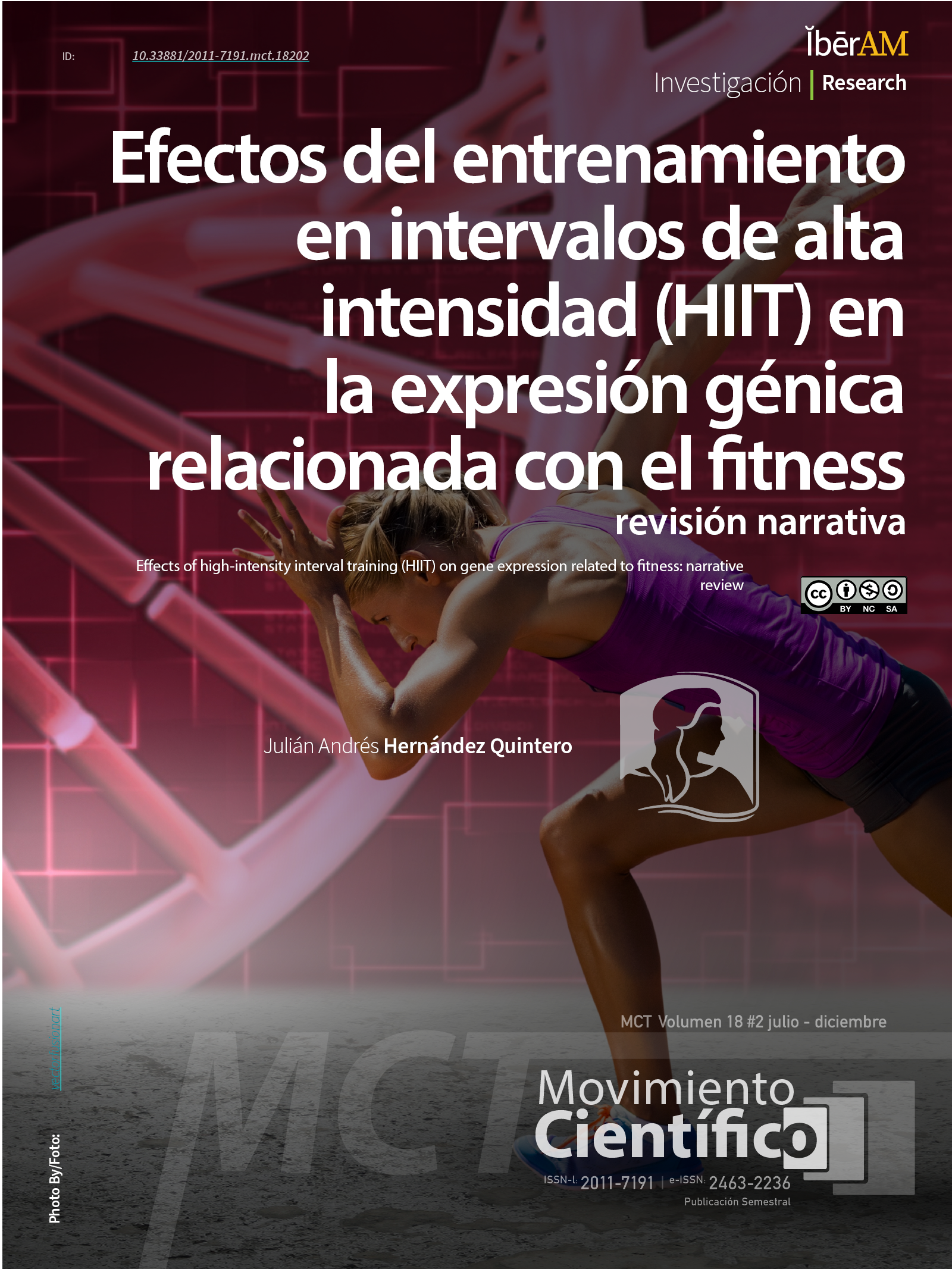Effects of high-intensity interval training (HIIT) on gene expression related to fitness
Efectos del entrenamiento en intervalos de alta intensidad (HIIT) en la expresión génica relacionada con el fitness Narrative review
Main Article Content
High-Intensity Interval Training (HIIT) has emerged as an effective strategy to improve physical fitness and modulate key metabolic and molecular processes. This study aims to analyze the effects of HIIT on gene expression related to fitness, focusing on pathways such as mitochondrial biogenesis, angiogenesis, energy metabolism, inflammation, and immune response. Method: A narrative review of 14 relevant studies was conducted after an exhaustive search on PubMed using terms like "HIIT," "gene expression," "mitochondrial biogenesis," and "angiogenesis." The included studies encompassed clinical trials, observational studies, and animal models investigating the impact of HIIT on gene expression. Extracted data included study type, HIIT protocol, population characteristics, methods of gene expression evaluation, and main outcomes. Results: The reviewed studies show that HIIT induces significant changes in key genes such as PGC-1α, VEGF, eNOS, IL-6, and various miRNAs, enhancing mitochondrial biogenesis, angiogenesis, energy metabolism, and immune response. Variations in HIIT protocols influence the magnitude of these molecular adaptations. Conclusion: HIIT is an effective intervention to improve physical fitness and modulate key genetic pathways, offering potential benefits for various populations, including individuals with chronic diseases and sedentary older adults. Customizing HIIT protocols can maximize these positive effects.
Downloads
Publication Facts
Reviewer profiles N/A
Author statements
Indexed in
-
—
- Academic society
- N/A
- Publisher
- Bogotá: Corporación Universitaria Iberoamericana
Article Details
Alihemmati, A., Ebadi, F., Moghadaszadeh, M., Asadi, M., Zare, P., & Badalzadeh, R. (2019). Effects of high-intensity interval training on the expression of microRNA-499 and pro- and anti-apoptotic genes in doxorubicin-cardiotoxicity in rats. Journal of Electrocardiology, 55, 9–15. https://doi.org/10.1016/J.JELECTROCARD.2019.02.009 DOI: https://doi.org/10.1016/j.jelectrocard.2019.02.009
Andonian, B. J., Johannemann, A., Hubal, M. J., Pober, D. M., Koss, A., Kraus, W. E., Bartlett, D. B., & Huffman, K. M. (2021). Altered skeletal muscle metabolic pathways, age, systemic inflammation, and low cardiorespiratory fitness associate with improvements in disease activity following high-intensity interval training in persons with rheumatoid arthritis. Arthritis Research & Therapy, 23(1). https://doi.org/10.1186/S13075-021-02570-3 DOI: https://doi.org/10.1186/s13075-021-02570-3
Andonian, B. J., Koss, A., Koves, T. R., Hauser, E. R., Hubal, M. J., Pober, D. M., Lord, J. M., MacIver, N. J., St Clair, E. W., Muoio, D. M., Kraus, W. E., Bartlett, D. B., & Huffman, K. M. (2022). Rheumatoid arthritis T cell and muscle oxidative metabolism associate with exercise-induced changes in cardiorespiratory fitness. Scientific Reports, 12(1). https://doi.org/10.1038/S41598-022-11458-4 DOI: https://doi.org/10.1038/s41598-022-11458-4
Bishop, D. J., Botella, J., Genders, A. J., Lee, M. J.-C., Saner, N. J., Kuang, J., Yan, X., & Granata, C. (2019). High-Intensity Exercise and Mitochondrial Biogenesis: Current Controversies and Future Research Directions. Physiology, 34(1), 56–70. https://doi.org/10.1152/physiol.00038.2018 DOI: https://doi.org/10.1152/physiol.00038.2018
Castro, V., Grisdale-Helland, B., Jørgensen, S. M., Helgerud, J., Claireaux, G., Farrell, A. P., Krasnov, A., Helland, S. J., & Takle, H. (2013). Disease resistance is related to inherent swimming performance in Atlantic salmon. BMC Physiology, 13(1). https://doi.org/10.1186/1472-6793-13-1 DOI: https://doi.org/10.1186/1472-6793-13-1
Cobley, J. N., Bartlett, J. D., Kayani, A., Murray, S. W., Louhelainen, J., Donovan, T., Waldron, S., Gregson, W., Burniston, J. G., Morton, J. P., & Close, G. L. (2012). PGC-1α transcriptional response and mitochondrial adaptation to acute exercise is maintained in skeletal muscle of sedentary elderly males. Biogerontology, 13(6), 621–631. https://doi.org/10.1007/s10522-012-9408-1 DOI: https://doi.org/10.1007/s10522-012-9408-1
Denham, J., Gray, A. J., Scott-Hamilton, J., Hagstrom, A. D., & Murphy, A. J. (2018). Small non-coding RNAs are altered by short-term sprint interval training in men. Physiological Reports, 6(7). https://doi.org/10.14814/phy2.13653 DOI: https://doi.org/10.14814/phy2.13653
Gorzi, A., Jafari, F., Allahmoradi, N., Rahmani, A., & Krause Neto, W. (2021). Training Intensity, Not Duration, May Be Key to Upregulating Presynaptic Proteins of Calcium Dynamics and Calcium-Dependent Exocytosis in Fast- and Slow-Twitch Skeletal Muscles, in Addition to Maintaining Performance After Detraining. Molecular Neurobiology, 58(12), 6670–6683. https://doi.org/10.1007/s12035-021-02576-7 DOI: https://doi.org/10.1007/s12035-021-02576-7
Kumar Dev, P., Gray, A. J., Scott-Hamilton, J., Hagstrom, A. D., Murphy, A., & Denham, J. (2021). Co-expression analysis identifies networks of miRNAs implicated in biological ageing and modulated by short-term interval training. Mechanisms of Ageing and Development, 199. https://doi.org/10.1016/j.mad.2021.111552 DOI: https://doi.org/10.1016/j.mad.2021.111552
Lionett, S., Kiel, I. A., Camera, D. M., Vanky, E., Parr, E. B., Lydersen, S., Hawley, J. A., & Moholdt, T. (2020). Circulating and Adipose Tissue miRNAs in Women With Polycystic Ovary Syndrome and Responses to High-Intensity Interval Training. Frontiers in Physiology, 11, 904. https://doi.org/10.3389/fphys.2020.00904 DOI: https://doi.org/10.3389/fphys.2020.00904
Luo, L., Liu, M., Xie, H., Fan, Y., Zhang, J., Liu, L., Li, Y., Zhang, Q., Wu, J., Jiang, C., & Wu, Y. (2021). High-Intensity Interval Training Improves Physical Function, Prevents Muscle Loss, and Modulates Macrophage-Mediated Inflammation in Skeletal Muscle of Cerebral Ischemic Mice. Mediators of Inflammation, 2021. https://doi.org/10.1155/2021/1849428 DOI: https://doi.org/10.1155/2021/1849428
Niño Méndez, Ó. A., Reina-Monroy, J. L., Ayala Pedraza, G., Portilla-Melo, J. G., Aguilar-Romero, I. D., Núñez-Espinosa, C. A., & Rodríguez-Mora, J. L. (2021). Efectos del entrenamiento de intervalos de alta intensidad en altitud simulada. Revista de Investigación e Innovación en Ciencias de la Salud, 3(1), 98-115. https://doi.org/10.46634/riics.50 DOI: https://doi.org/10.46634/riics.50
Miyamoto-Mikami, E., Tsuji, K., Horii, N., Hasegawa, N., Fujie, S., Homma, T., Uchida, M., Hamaoka, T., Kanehisa, H., Tabata, I., & Iemitsu, M. (2018). Gene expression profile of muscle adaptation to high-intensity intermittent exercise training in young men. Scientific Reports, 8(1). https://doi.org/10.1038/s41598-018-35115-x DOI: https://doi.org/10.1038/s41598-018-35115-x
Moris, R., Delgado-Floody, P., & Martínez-Salazar, C. (2020). El entrenamiento intervalado de alta intensidad incrementa la utilización de ácidos grasos en sujetos con sobrepeso u obesidad. Nutrición Hospitalaria, 37(3), 483-489. https://doi.org/10.20960/nh.02940
Plaza-Diaz, J., Izquierdo, D., Torres-Martos, Á., Baig, A. T., Aguilera, C. M., & Ruiz-Ojeda, F. J. (2022). Impact of Physical Activity and Exercise on the Epigenome in Skeletal Muscle and Effects on Systemic Metabolism. Biomedicines, 10(1). https://doi.org/10.3390/biomedicines10010126 DOI: https://doi.org/10.3390/biomedicines10010126
Robinson, M. M., Dasari, S., Konopka, A. R., Johnson, M. L., Manjunatha, S., Esponda, R. R., Carter, R. E., Lanza, I. R., & Nair, K. S. (2017). Enhanced Protein Translation Underlies Improved Metabolic and Physical Adaptations to Different Exercise Training Modes in Young and Old Humans. Cell Metabolism, 25(3), 581–592. https://doi.org/10.1016/j.cmet.2017.02.009 DOI: https://doi.org/10.1016/j.cmet.2017.02.009
Rundqvist, H., Augsten, M., Strömberg, A., Rullman, E., Mijwel, S., Kharaziha, P., Panaretakis, T., Gustafsson, T., & Östman, A. (2013). Effect of Acute Exercise on Prostate Cancer Cell Growth. PLoS ONE, 8(7), e67579. https://doi.org/10.1371/journal.pone.0067579 DOI: https://doi.org/10.1371/journal.pone.0067579
Scott, S. N., Shepherd, S. O., Hopkins, N., Dawson, E. A., Strauss, J. A., Wright, D. J., Cooper, R. G., Kumar, P., Wagenmakers, A. J. M., & Cocks, M. (2019). Home-hit improves muscle capillarisation and eNOS/NAD(P)Hoxidase protein ratio in obese individuals with elevated cardiovascular disease risk. The Journal of Physiology, 597(16), 4203–4225. https://doi.org/10.1113/JP278062 DOI: https://doi.org/10.1113/JP278062
Tomescu, A. I., Kuosmanen, A., Rizzi, R., & Mäkinen, V. (2013). A novel min-cost flow method for estimating transcript expression with RNA-Seq. BMC Bioinformatics, 14(SUPPL.5). https://doi.org/10.1186/1471-2105-14-S5-S15 DOI: https://doi.org/10.1186/1471-2105-14-S5-S15
Torma, F., Gombos, Z., Jokai, M., Takeda, M., Mimura, T., & Radak, Z. (2019). High intensity interval training and molecular adaptive response of skeletal muscle. Sports Medicine and Health Science, 1(1), 24–32. https://doi.org/10.1016/j.smhs.2019.08.003 DOI: https://doi.org/10.1016/j.smhs.2019.08.003
Tsuchiya, Y., Takakura, H., Osawa, S., & Izawa, T. (2023). Impact of high-intensity interval training on tendon related gene expression in rat Achilles tendon. Biochemical and Biophysical Research Communications, 658, 116–121. https://doi.org/10.1016/J.BBRC.2023.03.076 DOI: https://doi.org/10.1016/j.bbrc.2023.03.076
Vardar, S. A., Doganlar, Z. B., Kaya, O., Tayfur, P., Sut, N., & Doganlar, O. (2021). Different responses of apoptotic, inflammatory and heat shock protein gene expression to a single bout of high-intensity interval exercise between physically active and inactive men. Applied Physiology, Nutrition and Metabolism, 46(7), 743–752. https://doi.org/10.1139/apnm-2020-0783 DOI: https://doi.org/10.1139/apnm-2020-0783
Zhang, J., Wallace, S. J., Shiu, M. Y., Smith, I., Rhind, S. G., & Langlois, V. S. (2017). Human hair follicle transcriptome profiling: A minimally invasive tool to assess molecular adaptations upon low-volume, high-intensity interval training. Physiological Reports, 5(23). https://doi.org/10.14814/phy2.13534 DOI: https://doi.org/10.14814/phy2.13534















